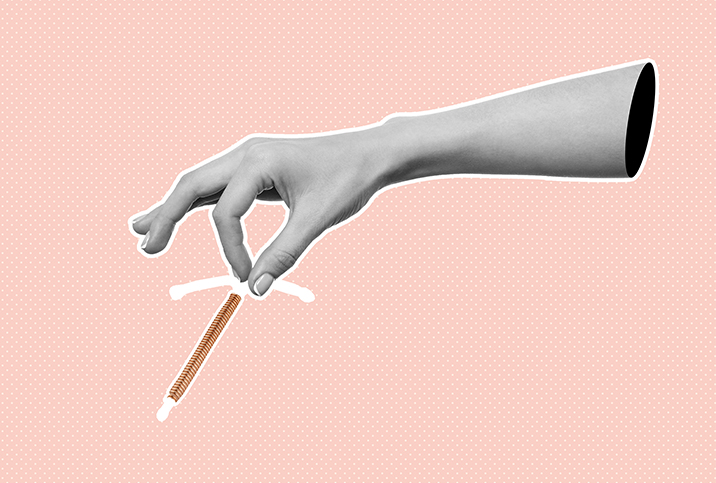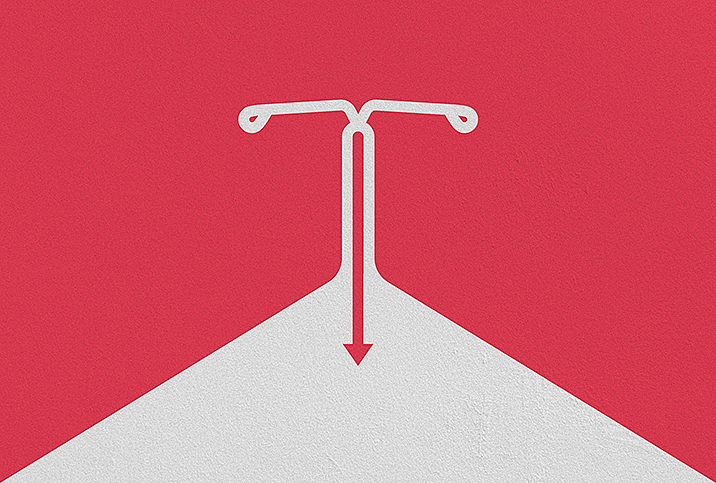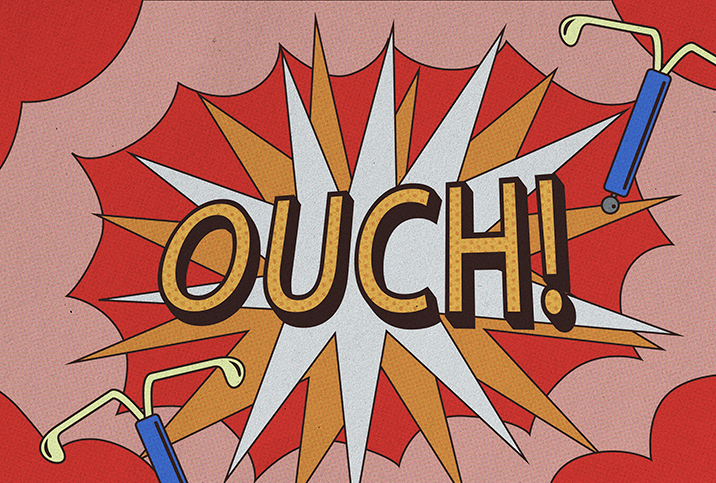Here's What IUD Insertion and Removal Feel Like

An intrauterine device (IUD) is a highly effective form of birth control. It's also a long-term, hands-off solution. If you've decided to get an IUD, here's what you can expect during your appointment.
What are the quick facts about an IUD?
An IUD is a small T-shaped device that sits in the uterus and is more than 99 percent effective at preventing unintended pregnancy, according to Planned Parenthood. Small fishing-wire-like strings extend from the device and through the cervix. Your doctor will trim these strings after insertion.
There are two types of IUDs—hormonal and copper—and five brands in all. Depending on the type and brand, IUDs can last 10 years or longer. You can get an IUD after birth, an abortion or anytime in the menstrual cycle.
Your doctor will help you decide which IUD is best for you.
What can you expect before IUD insertion?
Some healthcare professionals will schedule two appointments.
"Before having your coil fitted, you will have a brief consultation with your GP or healthcare professional and may be asked to do a pregnancy test and STI [sexually transmitted infections] test," said Mel Davis-Hall, B.M.B.S., B.Med.Sci., a general practitioner and the medical director at the Lowdown, a platform for women's sexual and reproductive health based in the United Kingdom.
The first appointment may include measuring your uterus to help determine the best IUD for your body, getting your sexual history, and a general check of your cervix and vagina. You'll learn about your IUD options and discuss the types.
The second appointment is to insert your IUD.
What happens before my IUD is inserted?
Numbing medications vary depending on the provider. Ask about your pain management options before your appointment.
"To make the IUD fitting procedure less uncomfortable, a local anesthetic spray may be used to numb the cervix. In some cases, a local anesthetic injection into the cervix may be used," Davis-Hall said.
"Some people are given medicine ahead of time to soften their cervix, instructed to take pain medication like ibuprofen an hour before the procedure, or given medicine to numb the cervix in the provider's office," said Stacey Rose, a sexologist and Ph.D. student in Somers Point, New Jersey.
Your appointment may be scheduled to coincide with the end of your period. The cervical os, or the opening in the cervix, is more open and can help with proper IUD placement.
How does my uterus get measured for an IUD?
You'll get undressed from the waist down, and lie on the exam room table like you would for your regular Pap smear.
At this point, Davis-Hall explained that the provider uses a speculum to open the vagina.
"After the local anesthetic has taken effect, an instrument is used to hold the cervix while the length of the uterus is measured," Davis-Hall said.
A doctor measures your uterus using a uterine sound, a thin, flexible piece of sterile plastic that can measure the depth and position of the uterus.
"My provider advised me this quick step was the most painful," said Rose, who uses an IUD. "Our bodies are all unique, so this will range from no big deal and mild discomfort to full stop seeing red."
What can you expect during IUD Insertion?
After your uterine cavity is measured to ensure the right fit, the IUD is readied for its insertion.
"The IUD is removed from its packaging, arms bent back, and the slider which houses the IUD is inserted and the IUD is released into the uterus. This part of the procedure took seconds," Rose said. "My body was already in full stress response mode, so pain sensations were raging through my body. Taking deep breaths or squeezing someone's hand can help if you are feeling pain or discomfort."
"I've had three different types of IUDs, starting with Paragard, and then Mirena and Kyleena," said Chicago-based Jennifer Lewis, who has used an IUD for almost two decades. "The hormonal IUDs are super easy, from insertion through their lifetime and removal. Insertion was over so fast with only a tiny, brief twinge of discomfort."
At this point, the provider can trim your IUD strings. They will also likely advise that you lie down for a few moments. You might feel dizzy after insertion, but Davis-Hall noted that this feeling should ease quickly.
"Procedures of this nature may trigger a medical condition known as a 'vaso-vagal response.' This causes a drop in blood pressure and heart rate, and you may feel nauseous, lightheaded or even faint," Davis-Hall said. "If you experience these symptoms, your healthcare provider may monitor your heart rate and blood pressure. These symptoms are short-lived, and your healthcare professional will have been trained to manage them."
You may feel pelvic pain and have heavy bleeding or spotty bleeding the first few months after IUD insertion. If you have any questions, contact your physician.
What can I expect when I have my IUD removed?
Having an IUD removed is usually less painful than insertion.
"The IUD removal is very simple and lasts a few minutes," Rose said.
Like most gynecologist appointments, you'll get undressed from the waist down, and you'll have a vaginal exam using the speculum, Davis-Hall said.
"Your provider inserts a speculum to widen the vaginal opening, then, with a tool, they will gently pull on the strings which dangle in your vaginal canal. This causes the IUD's arms to fold, and it should come right out," Rose said.
Rarely, a provider might experience difficulty removing an IUD, especially if the strings are not visible, Davis-Hall noted. In this case, you might be referred for an ultrasound scan or to a gynecologist if the threads retracted into the cervical canal.
What do I need to know following an IUD insertion or removal?
After the procedure, you might experience some cramping and spotting for a few months. You have medicinal options to help deal with cramping.
"Nonsteroidal anti-inflammatory drugs like ibuprofen are the best option," Davis-Hall said, adding it helps to rest for the remainder of the day.
In the case of bleeding or spotting, have pantyliners or pads on hand. You won't be able to use tampons or menstrual cups for 24 hours.
"You also can't have sex or take baths for at least 24 hours," Rose said.
To help circumvent any potential dizziness or faintness after insertion, David-Hall suggests eating your regular breakfast or lunch before the appointment, even if you're nervous.
"We also recommend wearing loose, comfy clothes," she said.
Your copper IUD will work immediately after insertion to help prevent pregnancy. The other methods may take a week before they offer you protection, according to Cleveland Clinic. You'll need to use another form of birth control in the meantime.
Your doctor will discuss the particulars regarding your device. You may receive a card with dates for IUD string checks or a reminder to schedule an appointment in the future.
The bottom line
"I've talked to other people who found the insertion totally easy breezy, but for me, this was one of the worst pains I've ever experienced. However, I don't regret my IUD at all and am grateful for it every day. It's the best $15 I've ever spent on a co-pay," Rose said.
"It's the fastest doctor's appointment I've ever had. My hormonal IUDs barely hurt—and I can hardly stand a paper cut. It's not like I'm a glutton for pain," Lewis added. "It's long-lasting without any work on my part."
After your appointment, you'll want to note when you're due for an IUD removal or a new IUD so you don't forget the month and year of your insertion appointment.


















